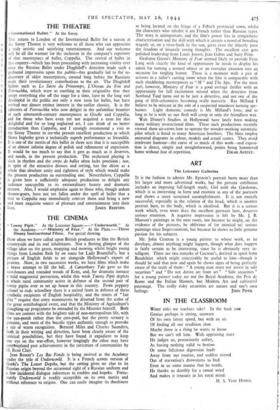International Ballet." At the Savoy. THE THEATRE
THE return to London of the International Ballet for a season at the Savoy Theatre is very welcome to all those who can appreciate a truly artistic and satisfying entertainment. And our welcome will be all the warmer for the inclusion in the company's repertory of that masterpiece of ballet, Cappello. The revival of ballet in this country—which has been proceeding with increasing vitality ever since the Russian Ballet under Diaghileff's direction made such a profound impression upon the public—has gradually led to the re- discovery of older, masterpieces, created long before the Russians made their revolutionary contributions to the art. The Diaghileff ballets such as Le Sacre du Printemps, L'Oiseau du Feu and Petrouchka, which were so startling in their originality that they swept everything else off the stage for a time, have in the long run developtd in the public not only a new taste for ballet, but have revived our almost extinct interest in the. earlier classics. It is the admirers of Petrouchka who now delight in the unfamiliar beauties of such nineteenth-century masterpieces as Giselle and Cappello, and for those who have even yet not acquired a taste for this delightful and for so long neglected art, I can think of no better introduction than Coppelia, and I strongly recommend a visit to the Savoy Theatre to see-the present excellent production in which Mona Inglesby gives a technically superb performance as Swanilda. It is one of the merits of this ballet in three acts that it is susceptible of an almost infinite degree of polish and refinement of expression. It would be too much to say that it gets as much as it deserves, and needs, in the present production. The orchestral playing is slack in rhythm and the corps de ballet often lacks precision ; nor, in spite of the attractive dreises and setting, has the decor as a whole that absolute unity and rightness of style which would make the present production an outstanding one. Nevertheless, Coppelia is given here a sufficiently adequate production to delight any audience susceptible to its extraordinary beauty and dramatic interest. Also, I would emphasise again to those who, though ardent theatre-goers, have not yet fallen under the spell of ballet that a visit to Coppelia may immediately convert them and bring a new and most exquisite source of pleasure and entertainment into their
a
e t
f
e
1


























 Previous page
Previous page